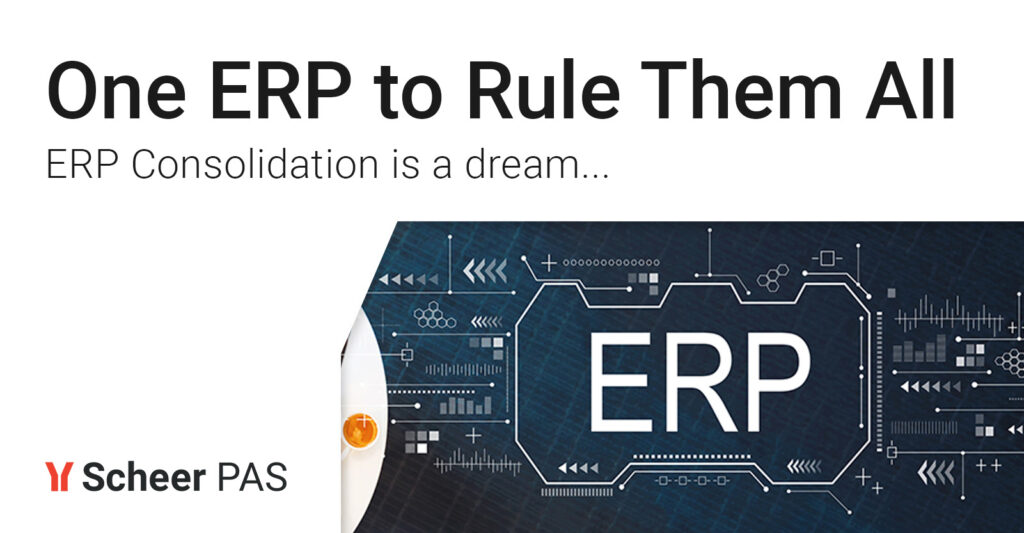One ERP to Rule Them All?

Enterprise Resource Planning (ERP) systems play a pivotal role in modern businesses, helping streamline processes and improve efficiency. However, managing multiple ERPs can lead to fragmentation and inefficiencies. To overcome this challenge, companies often embark on an ERP consolidation journey. So if your company is already on its journey or is thinking about starting one, let’s first jump into the key strategies for driving a successful ERP consolidation.
The Imagined Journey to ERP Consolidation

Before we explore the dos and don’ts, let’s take a look at the idealized path that many organizations think that they will go through. In this ideal scenario, different regional and global ERP systems are streamlined into a single and cohesive Global ERP system. The benefits are mostly clear – streamlined operations, improved data management, and enhanced decision-making capabilities.
Side note: If you want more info on how The Imagined Journey towards Consolidation (and even on the stage of Implementation), check out this link.
The Real Journey to ERP Consolidation

However, the reality of consolidation is always more complex. Organizations have to deal with multiple ERP systems, each with its own unique characteristics and challenges. The road to consolidation can involve a mix of regional ERPs, legacy systems, and newly acquired solutions. This complexity requires careful planning, execution, and the right platform.
Strategic Planning Assumptions

Gartner identifies several factors that can drive or hinder the success of ERP consolidation. To be more direct, this is what they have to say on ERP approach and the revision of their own systems:
“By 2026, more than 40% of large organizations with a global instance ERP approach will revisit their instance architecture.”
Tomas Kienast, Dixie John, 14th September 2023, Driving a Successful ERP
Consolidation Strategy, Gartner Application Innovation & Business Solutions Summit 2023, London, UK
On the positive side, agility in adapting to new business needs and the increasing adoption of Software as a Service (SaaS) and platform capabilities can be catalysts for consolidation. On the flip side, a lack of a business-led focus on Enterprise Resource and Planning strategy and the belief that centralized core ERP is the best way to manage IT workloads can be roadblocks.
Retrospective look
If you want to take a look at some of the older Gartner assumptions and see if they actually got some things right, check out this link.
Dos and Don’ts of ERP Consolidation

Do…
- Assess Operational and Strategic Fitness Factors: When embarking on ERP consolidation, it’s crucial to assess both operational and strategic fitness factors. Consider whether consolidation aligns with the organization’s long-term goals and whether it can adapt to evolving business needs.
- Recognize and Act on the Typical Challenges: ERP consolidation is not without its challenges. Be prepared to tackle issues such as data migration, user resistance, and integration complexities. Identifying and addressing these challenges proactively is crucial for success.
- Keep Composable Principles in Mind: Understand that not all ERP components are equal. Analysts like Gartner suggest categorizing them into Systems of Record, Systems of Differentiation, and Systems of Innovation. This approach allows you to tailor your consolidation strategy to specific business needs.
- Align Business Capabilities and ERP Strategy: Ensure that your ERP strategy aligns with the business’s capabilities. Different business units may have unique requirements, so flexibility should be balanced with enterprise standardization. There is some valuable research on this topic on this link if you want some more information.
- Assess Standardization vs. Flexibility Goals: Finding the right balance between standardization and flexibility is critical. Each organization’s ideal balance may differ depending on its industry, size, and specific needs.
Don’t…
- Restrict Architectural Options: Avoid the mistake of limiting your architectural options prematurely. There is a range of ERP architecture options, from independent operation to a single system with multiple instances, and highlights the pros and cons of each.
- Assume New Tech Solves Old Problems: While new technologies can offer innovative solutions, they don’t automatically resolve all existing issues. Evaluate how new tech fits into your consolidation strategy rather than blindly adopting it.
- Ignore Bad Factors: Consider factors that may lead you to rethink consolidation or standardization. These could include cultural, political, or other motivators that impact your organization’s unique dynamics.
Remember: Consolidation Is Not the Goal — Extract Value Out of Consolidation!

ERP consolidation is a complex journey that requires careful planning and execution. By following the dos and don’ts outlined in this blog post, organizations can embark on a successful consolidation strategy. However, the path to consolidation isn’t one-size-fits-all, and leveraging Application Composition Platforms like Scheer PAS can significantly aid in achieving your consolidation goals. Therefore, consolidating systems with microservices and interconnected services as opposed to building a monolithic ERP solution has several advantages, particularly in the context of a digital transformation. Some of them are:
- Scalability
- Enhanced Maintenance and Upgrades
- Interoperability
- Reduced Risk of Failure
- Customization
By incorporating Scheer PAS into your ERP consolidation strategy, you can harness the power of automation, streamline business processes, and ensure a successful transition to a consolidated ERP system interconnected with microservices. Scheer PAS acts as an enabler, supporting the journey toward a more efficient, integrated, and value-driven Enterprise, Resource and Planning landscape.
In summary, ERP consolidation is not just about reducing the number of systems; it’s about extracting maximum value and enhancing business capabilities. With a clear understanding of the dos and don’ts, and the use of Application Composition Platforms like Scheer PAS, organizations can transform their ERP landscape, making it more agile, efficient, and aligned with their long-term business goals.



